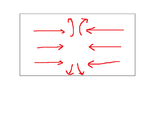Salvador12
Full Member level 4
Hi folks can you help me out with this, So there is a circular surface area , actually two such areas , in my example the area is 25cm in diameter, I need to produce a homogeneous B field through that area (flux lines all pointing in the same direction) and I need to do it in the RF frequency range,
I thought about using Helmholtz coils as they are usually made from two separate coils and I could put each of the circular planes right next to each coil,
Now the problem probably is how to achieve strong enough B field at such high frequencies? The coils would probably have to be made from some single loop water cooled tube or something like that because the B field strength that I'm aiming for (well as strong as possible would be great) but realistically speaking about 0.2?? Tesla?
Also even though I have searched the internet it is complicated to find them all at once I probably need formulas to calculate the inductance and capacitance of the coils and the necessary capacitor to put in series to make them resonant in order to decrease the total inductive resistance and have higher current hence larger field .
Thank you.
I thought about using Helmholtz coils as they are usually made from two separate coils and I could put each of the circular planes right next to each coil,
Now the problem probably is how to achieve strong enough B field at such high frequencies? The coils would probably have to be made from some single loop water cooled tube or something like that because the B field strength that I'm aiming for (well as strong as possible would be great) but realistically speaking about 0.2?? Tesla?
Also even though I have searched the internet it is complicated to find them all at once I probably need formulas to calculate the inductance and capacitance of the coils and the necessary capacitor to put in series to make them resonant in order to decrease the total inductive resistance and have higher current hence larger field .
Thank you.
